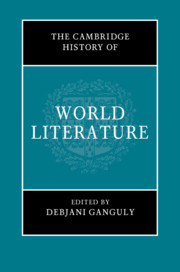Book contents
- The Cambridge History of World Literature
- The Cambridge History of World Literature
- Copyright page
- Contents
- Figures
- Contributors
- Acknowledgements
- Introduction
- Part I Genealogies
- Part II Thinking the World
- Part III Transregional Worlding
- Part IV Cartographic Shifts
- Part V World Literature and Translation
- Part VI Poetics, Genre, Intermediality
- Part VII Scales, Polysystems, Canons
- 36 Spatial Scale and the Urban Everyday: The Physiology as a Traveling Genre (Paris, St. Petersburg, Tiflis)
- 37 Imaginative Geographies in the Medieval Islamic Republic of Letters
- 38 The Anthology as the Canon of World Literature
- 39 Data Worlds: Patterns, Structures, Libraries
- Part VIII Modes of Reading and Circulation
- Part IX The Worldly and the Planetary
- Index
- References
39 - Data Worlds: Patterns, Structures, Libraries
from Part VII - Scales, Polysystems, Canons
Published online by Cambridge University Press: 17 August 2021
- The Cambridge History of World Literature
- The Cambridge History of World Literature
- Copyright page
- Contents
- Figures
- Contributors
- Acknowledgements
- Introduction
- Part I Genealogies
- Part II Thinking the World
- Part III Transregional Worlding
- Part IV Cartographic Shifts
- Part V World Literature and Translation
- Part VI Poetics, Genre, Intermediality
- Part VII Scales, Polysystems, Canons
- 36 Spatial Scale and the Urban Everyday: The Physiology as a Traveling Genre (Paris, St. Petersburg, Tiflis)
- 37 Imaginative Geographies in the Medieval Islamic Republic of Letters
- 38 The Anthology as the Canon of World Literature
- 39 Data Worlds: Patterns, Structures, Libraries
- Part VIII Modes of Reading and Circulation
- Part IX The Worldly and the Planetary
- Index
- References
Summary
The emergence of world literary studies and the digital turn in literary studies share a seminal text in Franco Moretti’s “Conjectures on World Literature.” Since that article was published in 2000, the ongoing digitization of cultural collections and emergence of new computational methods of analysis have only increased the excitement of some, and concern of others, that digital research will become a major, even a dominant, trajectory in world literary studies. But the associated claim – by critics and proponents alike – that digital approaches represent a paradigmatic shift ignores major continuities between digital research and the non-digital scholarship that preceded and continues alongside it, including in world literary studies. Much of the traction that Moretti’s “distant reading” has gained can be ascribed to commonalities in the conceptions of archives, and foregrounding of networks and patterns, in non-digital scholarship. And Moretti’s claim that “distant reading” dismantles traditional, specifically national and canonical, frameworks is not true of most digital literary projects, including the majority of Moretti’s own experiments. Such continuities, and the resulting disjunction between enactments of digital research and the global and democratic rhetoric in which new technologies are often couched, arise from the substantial ways in which pre-digital traditions, ideologies, and infrastructures shape digital resources and methods. Recognizing and interrogating this inheritance, an emerging group of digital projects advance key aims of world literary studies including situating literature “within a vast transnational library,” expanding “the canon of the literary properly to reflect global diversity,” and offering new conceptual frameworks that “adjust our reading of the novel to world scale” (Smith 92).
Keywords
- Type
- Chapter
- Information
- The Cambridge History of World Literature , pp. 765 - 786Publisher: Cambridge University PressPrint publication year: 2021
References
- 1
- Cited by

